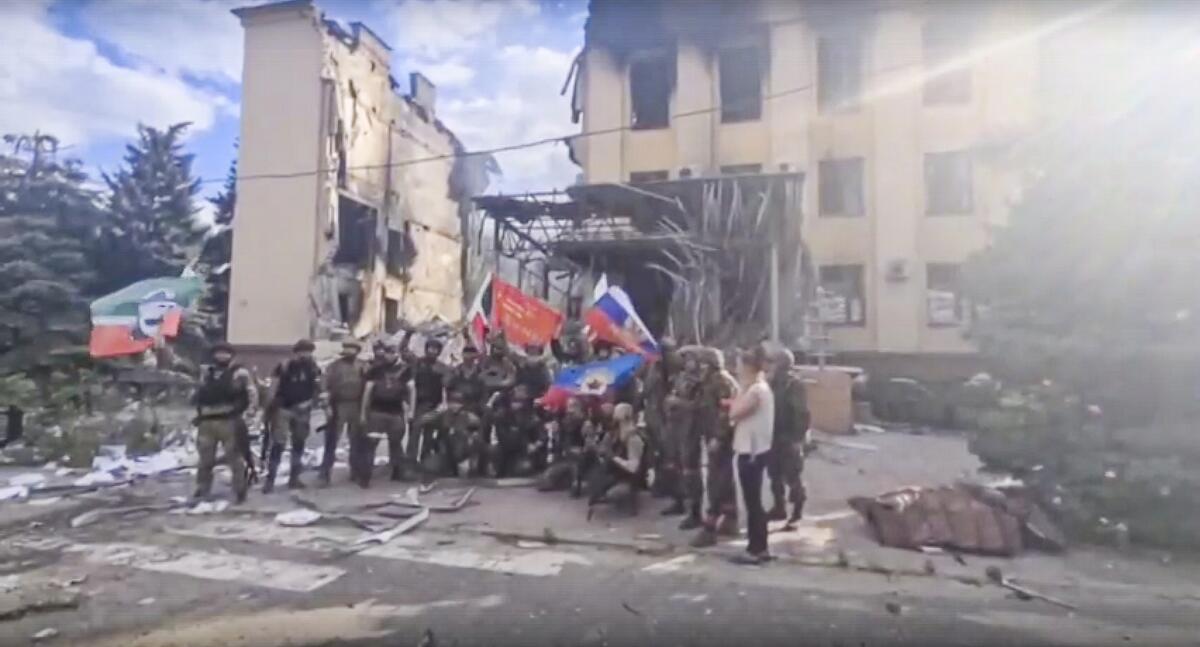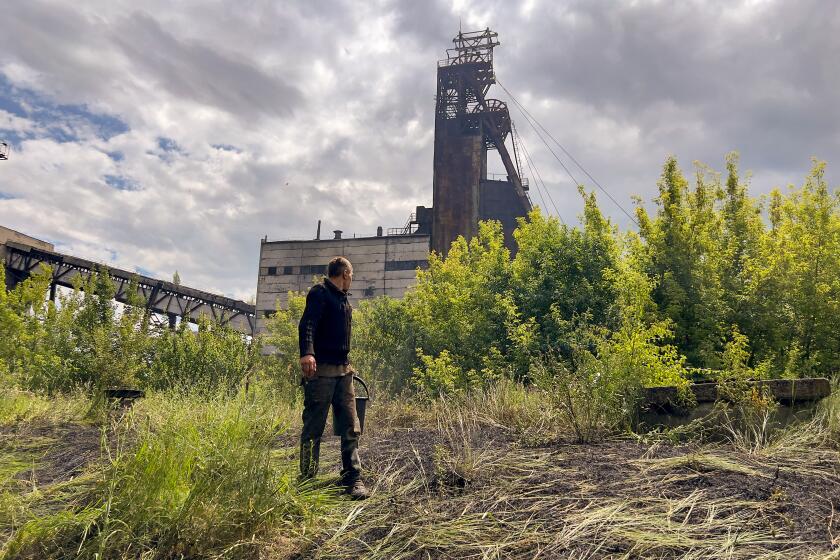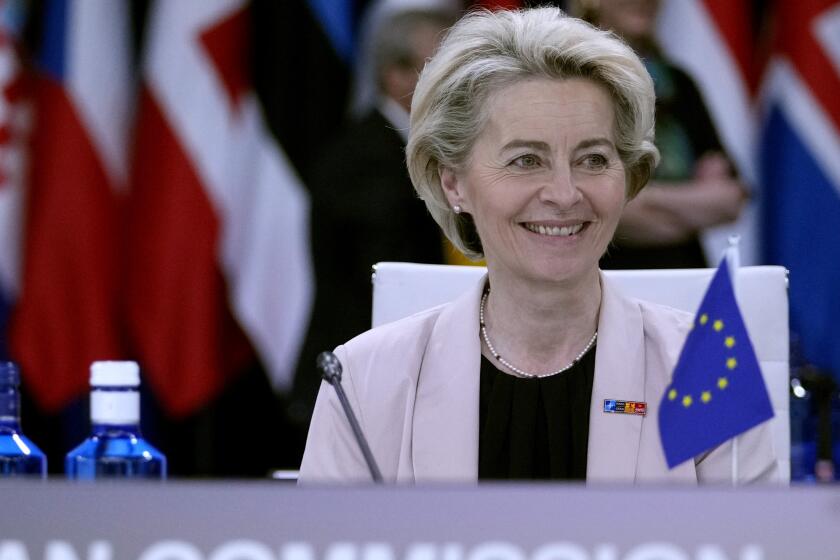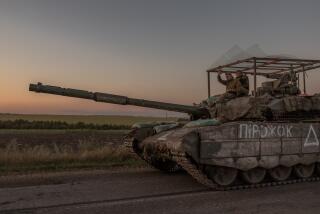High cost of Russia’s gains in east Ukraine could limit any new offensive

- Share via
After more than four months of ferocious fighting, Russia has claimed a key victory: full control over one of the two provinces in the Donbas, Ukraine’s eastern industrial heartland.
But Moscow’s rout of the last bulwark of Ukrainian resistance in Luhansk province came at a steep price. The critical question now is whether Russia can muster enough strength for a new offensive to complete its seizure of the Donbas and make gains elsewhere in Ukraine.
“Yes, the Russians have seized the Luhansk region, but at what price?” asked Oleh Zhdanov, a military analyst in Ukraine, noting that some Russian units involved in the battle lost up to half their soldiers.
Even Russian President Vladimir Putin acknowledged Monday that Russian troops involved in action in Luhansk need to “take some rest and beef up their combat capability.”
That raises doubts about whether Moscow’s forces and their separatist allies are ready to quickly thrust deeper into Donetsk, the other province that makes up the Donbas. Observers estimated in recent weeks that Russia controlled about half of Donetsk, and battle lines have changed little since then.
What happens in the Donbas could determine the course of the war. If Russia succeeds there, it could free up its forces to grab even more land and dictate the terms of any peace agreement. If Ukraine, on the other hand, manages to pin the Russians down for a protracted period, it could build up the resources for a counteroffensive.
Ukrainian soldiers returning from the front in eastern Ukraine’s Donbas describe the situation there as apocalyptic in the fight against Russia.
Exhausting the Russians has long been part of the plan for the Ukrainians, who began the conflict outgunned — but who hoped that Western weapons could eventually tip the scales in their favor.
They are already effectively using heavy howitzers and advanced rocket systems sent by the U.S. and other Western allies, and more weaponry is on the way. But Ukrainian forces have said they remain badly outmatched.
Ukrainian Defense Minister Hanna Malyar said recently that Russian forces were firing 10 times more ammunition than the Ukrainian military.
After a failed attempt at a lightning advance on the capital of Kyiv in the opening weeks of the war, Russian forces withdrew from many parts of northern and central Ukraine and turned their attention to the Donbas, a region of mines and factories where Moscow-backed separatists have been fighting Ukrainian forces since 2014.
Since then, Russia has adopted a slow-and-steady approach that allowed it to seize several remaining Ukrainian strongholds in Luhansk over the course of recent weeks.
While Ukrainian officials have acknowledged that their troops have withdrawn from the city of Lysychansk, the last bulwark of their resistance, the president’s office said the military was still defending small areas in Luhansk.
Zhdanov, the analyst, predicted that the Russians would likely rely on their edge in firepower to “apply the same scorched-earth tactics and blast the entire cities away” in Donetsk. The same day that Russia claimed that it had taken Lysychansk, new artillery attacks were reported in cities in Donetsk.
But Russia’s approach is not without drawbacks. Moscow has not given a casualty count since saying some 1,300 troops were killed in the first month of fighting. Western officials have said that was just a fraction of real losses. Since then, Western observers have noted that the number of Russian troops involved in combat in Ukraine has dwindled, reflecting both heavy attrition and the Kremlin’s failure to fill up the ranks.
Relentless Russian artillery barrages have battered Ukraine’s powerful coal industry and endangered miners working underground. “No one wants to risk getting trapped down there,” said one.
The limited manpower has forced Russian commanders to avoid ambitious attempts to encircle large areas in the Donbas, opting for smaller maneuvers and relying on heavy artillery barrages to slowly force the Ukrainians to retreat.
The military has also relied heavily on separatists, who have conducted several rounds of mobilization, and Western officials and analysts have said Moscow has increasingly engaged private military contractors. It has also tried to encourage the Russian men who have done their tour of duty to sign up again, though it is unclear how successful that has been.
While Putin so far has refrained from declaring a broad mobilization that might foment social discontent, recently proposed legislation suggested that Moscow was looking for other ways to replenish the ranks. The bill would have allowed young conscripts, who are drafted into the army for a year and barred from fighting, to immediately switch their status and sign contracts to become full professional soldiers. The draft was shelved amid strong criticism.
Some Western officials and analysts have argued that attrition is so heavy that it could force Moscow to suspend its offensive at some point later in the summer, but the Pentagon has cautioned that, even though Russia has been churning through troops and supplies at rapid rates, it still has abundant resources.
Start your day right
Sign up for Essential California for the L.A. Times biggest news, features and recommendations in your inbox six days a week.
You may occasionally receive promotional content from the Los Angeles Times.
U.S. director of national intelligence Avril Haines said Putin appeared to accept the slow pace of the advance in the Donbas and now hoped to win by crushing Ukraine’s most battle-hardened forces.
“We believe that Russia thinks that if they are able to crush really one of the most capable and well-equipped forces in the east of Ukraine ... that will lead to a slump basically in the Ukrainian resistance and that that may give them greater opportunities,” Haines said.
If Russia wins in the Donbas, it could build on its seizure of the southern Kherson region and part of the neighboring Zaporizhzhia region to try to cut Ukraine off from its Black Sea coast all the way to the Romanian border. If that succeeded, it would deal a crushing blow to the Ukrainian economy and also create a corridor to Moldova’s separatist region of Transnistria, which hosts a Russian military base.
But that is far from assured. Mykola Sunhurovsky of the Razumkov Center, a Kyiv-based think tank, predicted that growing supplies of heavy Western weapons, including HIMARS multiple-rocket launchers, will help Ukraine turn the tide of the war.
The European Union’s executive arm has pledged to draft an emergency plan aimed at helping member countries do without Russian energy in the wake of the Kremlin’s war in Ukraine
“The supplies of weapons will allow Ukraine to start a counteroffensive in the south and fight for Kherson and other cities,” Sunhurovsky said.
But Ukraine has also faced massive personnel losses: up to 200 soldiers a day in recent weeks of ferocious fighting in the east, according to officials.
“Overall, local military balance in Donbas favors Russia, but long-term trends still favor Ukraine,” wrote Michael Kofman, an expert on the Russian military and program director at the Virginia-based CNA think tank. “However, that estimate is conditional on sustained Western military assistance, and is not necessarily predictive of outcomes. This is likely to be a protracted war.”
More to Read
Sign up for Essential California
The most important California stories and recommendations in your inbox every morning.
You may occasionally receive promotional content from the Los Angeles Times.
















